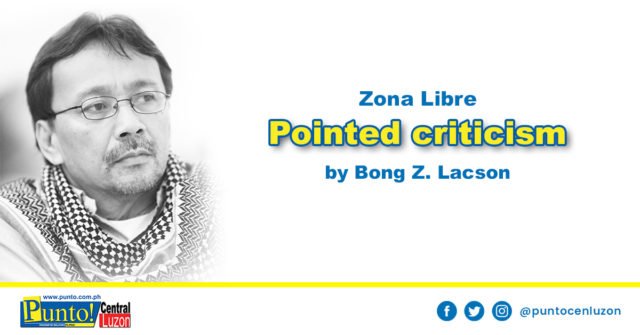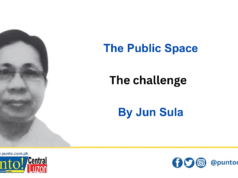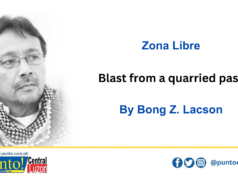NO OTHER local paper has been as remarkably biting as Punto! right at its very aborning. Debuting in late September 2007, here’s what we penned here of the paper by early October – of the same year.
PUNTO! Central Luzon edition, in less than two weeks is already impacting itself in the local consciousness. Proof positive of this are the stinging remarks hurled at the paper – such as “’tang nang Punto!” – by some onions who felt they’ve been skinned too closely.
To them and to others who may be “Puntoed” someday, find solace or distress in our piece On Criticism published in a different paper in 2001 but finding greatest attribution to Punto!
TO AFFLICT the comfortable and comfort the afflicted.
That is the social calling of the committed critic. He of the journalistic species, as extracted from the larger literary genus.
Criticism by itself though is never an end. It is a multi-faceted means to primarily expose, expound, and examine acts within the ambit of human wrongs as delineated by society’s mores, traditions and laws. With the express purpose of righting those wrongs.
Nowhere is the praxis of journalistic criticism more pervasive, prevalent and pronounced than in the field of governance. This, arising from the tradition of adversarial relationship between a free press and the government.
Public office being a public trust requires public scrutiny. Not an iota less than open, constant, vigilant inquiry. Else, public office will easily degenerate into private enterprise. For the corruptive essence of power – attendant to any public office – mixed with inhered human frailty is one sure-fire formula for debauchery.
Here lies a grave danger to society. Here stand guard media, committed and free. All these prominently exemplified in contemporary history that is too recent to fade from the people’s collective memory. Or have we forgotten Martial Law? (Closer to home now, how the public coffers bulging with the quarry funds were turned into personal piggybanks, nay, ATM accounts by you-know-who.)
Criticism is painful, for truth hurts.
Going by the medicinal analogy: 1) it is a very bitter pill, hard to swallow; 2) the greater the dose, the harder it gets down one’s throat; 3) consequently though, the faster the healing, the more efficacious the cure.
Like medicine to physiological well-being, criticism strengthens character-building. The committed critic assumes here the role of a doctor doing a physical check-up on a diseased body, identifying symptoms, dispensing with prescriptions. To better the person.
There is thus an essential altruism in criticism. As the great French philosopher and essayist Michel Eyquem de Montaigne writes: “We need very strong ears to hear ourselves judged frankly, and because there are few who can endure frank criticism without being stung by it, those who venture to criticize us perform a remarkable act of friendship, for to undertake to wound or offend a man for his own good is to have a healthy love for him.”
Comes to mind here the friendships I have kept as well as those I lost and discarded – not principally due to my critical mindset but rather predicated on a personal dictum: “If I cannot anymore say – in your face – the things you do not want to hear, then I have ceased being your friend.
STILL, criticism stings.
And there can be no way to ignore, to be immune from the personal hurt it inflicts upon its object. Tao lang po, as some wag is wont to say.
To his critics, unseated President Joseph Estrada offered this mantra: “Tawagin n’yo na akong bobo, huwag lang magnanakaw.”
Thus, he even reveled on the so-called “Eraptions” that insulted his (un)intelligence. But promptly filed a libel suit against the then Gokongwei-owned The Manila Times over its “unwitting godfather” banner story on the Impsa deal.
Libel is a course of action for the afflicted official. That is a fundamental right respected by even the harshest critic. But libel is by no means the only recourse to redress the infliction.
Enshrined in jurisprudence is this decision on U.S. vs. Bustos: “Men in public life may suffer under a hostile and unjust accusation: the wound can be assuaged with the balm of a clear conscience.”
A clear conscience is the Teflon or the Kevlar that protects him who is not at fault, who has done no wrong, from every brickbat thrown at his person. Even as a guilty one is the festering wound that stinks and hurts like hell when exposed to open air.
So how to deal with criticism?
One, grin and bear it.
As U.S. vs. Bustos again holds: “A public officer must not be too onion-skinned with reference to comment upon his official acts. Only thus can the intelligence and dignity of the individual be exalted.”
There, criticism serves as the crucible of character refinement. A necessary, albeit painful, cleansing process. Clear too to the critic, comment on official acts, not private deeds or personal habits.
Two, follow Zeno. Be a Stoic.
Calmly, accept all pain – as well as all joy – as inevitable, as the very dictates of the divine will to which one must completely surrender. To us Filipinos, this is “Ipasa-Diyos na lang natin ang lahat.”
Three, if you cannot stand the heat, don’t just get out of the kitchen. Go to someplace cooler, like the Arctic and swim with the seals, waddle with the penguins, or wrestle with the polar bears. There you’d be totally out of criticism’s reach.
Finally, to the critic, a quote from the very quotable American President Harry “Give ‘em hell” S. Truman: “I never give them hell. I just tell the truth, and they think it is hell.”
Oops, there is a pahabol — Why not just ignore the criticism and the critic?
Indeed, why not? So long as you can live happily ever after notwithstanding the snide remark, the knowing smirk, the insulting laugh thrown at your back by everyone that has read or heard him?
Go, figure.





